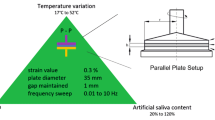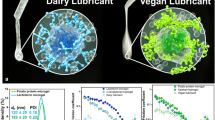Abstract
Purpose. This study examined the viscoelastic properties of bioadhesive, chlorhexidine-containing semi-solid formulations, designed for topical application to the oropharynx.
Methods. Oscillatory rheometry was performed using a Carri-Med CSL2-100 rheometer at 20.0 ± 0.1° C in conjunction with parallel plate geometry (2 cm diameter, 0.5 mm sample thickness). Samples were subjected to a constant strain (6.5 × 10−3 rad) and defined viscoelastic parameters, namely storage modulus (G′), loss modulus (G″), loss tangent (tan δ) and dynamic viscosity (η′), measured over a defined frequency range (0.01-1.0 Hz).
Results. As the oscillatory frequency was increased, G′ G″ of all formulations increased, whereas both η′ and tan δ significantly decreased. The magnitude of increase of G′ and G″ as a function of frequency was relatively small, indicating that, in general, the formulations were non-cross-linked elastic systems. Increasing concentrations of HEC, PVP and PC significantly increased G′, G″,η′ yet decreased tan δ′ observations that may be attributed to the physical state of each polymer in the formulations. Formulation elasticity increased (i.e. tan δ decreased) as a result of increased entanglement of polymeric chains of dissolved components (i.e. HEC and PVP) and the restrained extension of swollen, cross-linked chains of PC. Additionally, in formulations where the saturation solubility of PVP was exceeded and/or insufficient 'free-water' was available for maximal swelling of PC, formulation elasticity increased as a result of the increasing mass of dispersed solid particles of PVP and/or PC. Formulation η′ increased due to the attendent effects of polymer chain entanglement and polymer state on overall formulation viscosity.
Conclusions. Following application to the oropharynx, the formulations will behave as elastic systems. Thus, these formulations would be expected to offer advantageous clinical properties, e.g., prolonged drug release, increased bioadhesion. However, it is noteworthy that the final choice of formulation for clinical evaluation will involve a compromise between viscoelastic characteristics and acceptable textural properties, e.g. ease of product application. This study has shown the applicability of oscillatory rheometry for both the characterisation and selection of candidate, topical bioadhesive formulations for clinical evaluation.
Similar content being viewed by others
REFERENCES
M. Addy, Local delivery of antimicrobial agents to the oral cavity. Adv. Drug Deliv. Rev. 13:123–134 (1994).
A. E. Collins, and P. B. Deasy, Bioadhesive lozenge for the improved delivery of cetylpyridinium chloride. J. Pharm. Sci., 79:116–119 (1990).
J. Smid-Korbar, J. Kristl, L. Cop, and D. Groselj, Formulation and evaluation of oral mucoadhesive films containing metronidazole. Acta Pharm. Jugosl., 41:251–258 (19910.
D. S. Jones, A. D. Woolfson, and A. F. Brown, Textural analysis and flow rheometry of bioadhesive, antimicrobial oral gels. Pharm. Res., 14:450–457 (1997).
D. S. Jones, A. D. Woolfson, and A. F. Brown, Textural, viscoelastic and mucoadhesive properties of pharmaceutical gels composed of cellulose polymers Int. J. Pharm. 151:223–233 (1997).
S. Y. Lin, G. L. Amidon, N. D. Weiner, and A. H. Goldberg, Viscoelasticity of cellulose polymers and mucocilliary transport on frog palates. Int. J. Pharm., 95:57–65 (1993).
S. Tamburic, and D. Q. M. Craig, An investigation into the rheological, dielectric and mucoadhesive properties of poly(acrylic acid) gel systems. J. Contr. Rel., 37:59–68 (1995).
S. S. Davis, Viscoelastic properties of pharmaceutical semi-solids. III. Non-destructive oscillatory testing J. Pharm. Sci., 60:1351–1356 (1971).
M. M. Talukdar, I. Vinckier, P. Moldenaers, and R. Kinget, Rheological characterisation of xanthan gum and hydroxypropylmethylcellulose with respect to controlled-release drug delivery. J. Pharm. Sci., 85:537–540 (1996).
D. Q. M. Craig, S. Tamburic, G. Buckton, and J. M. Newton, An investigation into the structure and properties of carbopol 934 gels using dielectric spectroscopy and oscillatory rheometry. J. Contr. Rel., 30:213–223 (1994).
B. W. Barry, and M. C. Meyer, The rheological properties of Carbopol gels I. Continuous shear and creep properties of Carbopol gels. Int. J. Pharm., 2:1–25 (1979).
S. S. Davis, Viscoelastic properties of semi-solids. I. Ointment bases. J. Pharm. Sci. 58:412–418 (1969).
S. Tamburic, D. Q. M. Craig, G. Vuleta, and J. Milic, A comparison of electrical and rheological techniques for the characterisation of creams Int. J. Pharm., 137:243–248 (1996).
J. D. Ferry, Viscoelastic properties of polymers, 3rd Edition, Wiley, New York, pp 33–130 (1980).
B. W. Barry, and M. C. Meyer, The rheological properties of carbopol gels II. Oscillatory properties of carbopol gels. Int. J. Pharm., 2:27–40 (1979).
J. S. Chu, D. M. Yu, G. L. Amidon, N. D. Weiner, and A. H. Goldberg, Viscoelastic properties of polyacrylic acid gels in mixed solvents. Pharm. Res., 9:1659–1663 (1992).
Y. Majima, K. Hirata, K. Takeuchi, M. Hattori, and Y. Sakarura, Effects of orally administered drugs on dynamic viscoelasticity of human nasal mucus. Am. Rev. Respir. Dis., 141:79–83 (1990).
D. S. Jones, A. D. Woolfson, J. Djokic, and W. A. Coulter, Development and physical characterisation of bioadhesive semisolid, polymeric systems containing tetracycline for the treatment of periodontal diseases. Pharm. Res. 13:1734–1738 (1996).
S. Bolton, Pharmaceutical Statistics, Marcel Dekker, New York, pp. 218–256 (1984).
Author information
Authors and Affiliations
Rights and permissions
About this article
Cite this article
Jones, D.S., Woolfson, A.D. & Brown, A.F. Viscoelastic Properties of Bioadhesive, Chlorhexidine-Containing Semi-Solids for Topical Application to the Oropharynx. Pharm Res 15, 1131–1136 (1998). https://doi.org/10.1023/A:1011906917084
Issue Date:
DOI: https://doi.org/10.1023/A:1011906917084




